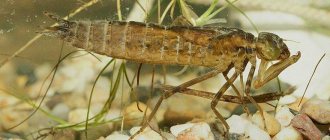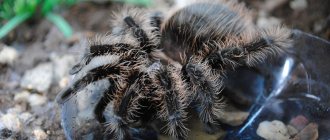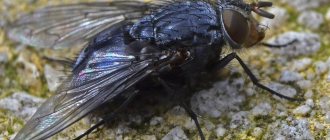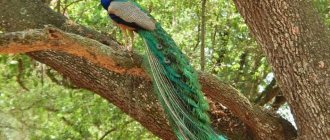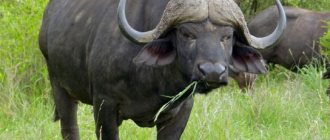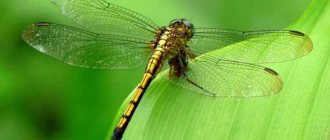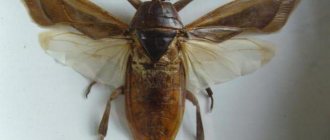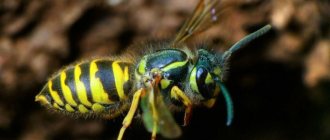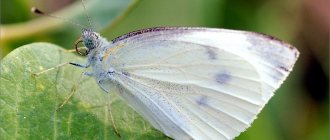Description of Sympetrum vulgatum
Insect classification:
- Order – dragonflies (Odonata).
- Family – true dragonflies (Libellulidae).
- Genus – compressed bellies (Sympetrum).
- Species: common dragonfly (Sympetrum vulgatum).
Body structure and coloring
Dragonflies from the genus Sympetrum or compressed bellies are typical representatives of the fauna of Russia. Their body length is 38-40 mm, of which the abdomen accounts for up to 28 mm. The head is large, well defined, mobile. In the imago it is wider than the thorax and is movably connected to the prothorax. The eyes are large, complex, and consist of 20-30 thousand individual facets. The upper part of the organ is responsible for recognizing the outline of objects, and the lower part distinguishes colors. The antennae are presented in the form of short thin bristles. There are three simple ocelli located on the crown. A black stripe runs across the brown head, between the crown and forehead. The mouthparts are of a gnawing type, with strong mandibles equipped with sharp teeth.
The insect's chest contains limbs and two pairs of wings. The posterior part of the prothorax has a vertical projection. A fringe of long hairs grows on it. Black stripes run along the chest seams. The back of the dragonfly is pushed back obliquely, so the wings are behind the limbs. Males of the common compressed belly have a red chest with three black stripes, females are yellow-brown, three stripes are also present.
Wings
Dragonflies are equipped with two pairs of wings. In heteroptera, the front pair exceeds the parameters of the rear pair. The wing plate is formed by two chitinous layers and reinforced by veins. Their length is approximately equal to the size of the body. The hind wings are widened at the base. The wingspan of Sympetrum vulgatum is 60 mm, the length of the hind wing is 24-29 mm, the length of the front wing is 33-37 mm. The venation is very dense, large veins contain hemolymph, small veins have no gaps. One of the significant areas is the pterostigma, a thickening in the front of the wings. Outwardly, it looks like a dark spot; during flight, it weighs down the top of the wing, allowing it to increase the amplitude of the flapping.
Limbs
The legs of the common dragonfly are black, with a yellow stripe running along the outside. Three pairs of limbs are designed to hold the insect's body and catch prey. They are not used for walking or running. The legs consist of 5 main parts:
- basin;
- trochanter;
- hip;
- shin;
- paw.
On the inside of the leg and thigh there are several rows of spiny bristles. The coxa is the thickest and shortest part of the limb. There are two sharp forked claws on the foot. Long limbs and spines allow them to form a “catching basket” to catch prey in the air.
Abdomen
The abdomen of the common dragonfly is flattened and wide. It consists of 10 full and one rudimentary segment. Each part is formed by an upper and lower chitinous shield. Thanks to the movable joint, insects can freely bend their abdomen. The structure of the organ of males and females is different. Males have special appendages on the last segment to hold the partner during mating. Their secondary copulatory organ is located in the lower part of the second segment. The female's genital opening is between the eighth and ninth segments. Females have an ovipositor. Males have a red abdomen with a black side stripe, while females have a brown abdomen with a black stripe.
Larvae
Dragonfly larvae are called nymphs or naiads. In appearance and structure they are strikingly different from the imago. Nymphs of the common dragonfly have a massive body 17-19 mm long. Breathing is carried out through internal organs - rectal gills. The larvae take water into the rectum, where gas exchange occurs. The body color is dark gray, greenish or red-brown. The nymphs are covered with a motley pattern.
Forehead with a T-shaped black spot; runs along the border of the forehead and clypeus
^ Green rocker (Ae. Viridis) ^ Blue rocker (Ae. Cyanea) ^ Large rocker (Ae. Grandis) ^ Genus Watcher –Anax Leach. ^ Emperor Watcher (Anax Imperator) ^ Family True dragonflies - Libellulidae. ^ Genus Libellula (libellula) Flat dragonfly (Libellula depressa) ^ Genus Orthetrum (orthetrum) Newm. ^ Lattice dragonfly
(O. cancellatum). Genus Sympetrum (sympetrum) Newm. ^ Yellowish dragonfly (S. Flaveolum) ^ Common dragonfly (S. Vulgatum).
- Bandaged dragonfly (S. pedemontanum)
- Black dragonfly (S. Danae sulzer)
- Blood red dragonfly (S. Sanguineur).
Genus Reucorrhinia (Leucorrhinia) Britt.
- White-fronted dragonfly (L. albifrons);
- Red dragonfly (L. rubicunda);
- Swamp dragonfly (L. pectoralis).
Grandmother family - Corduliidae. ^ Genus Grandmother – Cordulia Leach. Bronze headstock (C. Aenea).
Genus Somatochlora (somatochlora) Selys
Form and structure
The female dragonfly lays eggs in water, attaching them to a variety of plants, silt or moss. After 14-35 days, arachnid pre-larvae hatch from them (less than 1 mm), immediately molt, then move to the next stage and continue their development in the water element. Oddly enough, the dragonfly larva is called a nymph, or a naiad. Whoever came up with this clearly had a good sense of humor.
The respiratory system and oral apparatus of a nymph are radically different from that of an adult. This is due to the aquatic lifestyle. The naiad breathes through gills, a kind of organ located in the hindgut. Oxygen enters through the anus along with water. The larva sucks it in like a powerful vacuum cleaner.
The “spent fuel” is thrown out with force, like a jet stream, and pushes the naiad forward. This is how she moves.
Appearance of a naiad
The dragonfly larva looks like a caricature of a cockroach drawn by different artists. Depending on the species and group to which the adult belongs, the body of the nymph can have a different shape. For some it is thick and short, for others it is more elongated and slender. In its front part there are three pairs of legs. In relation to the body, they are longer than those of an adult dragonfly. An interesting feature is that in the early stages of its development, a naiad can regrow a severed leg.
Body color varies in olive-brown tones.
On the sedentary head of the nymph, huge compound eyes stand out on the sides, and a well-developed jaw, which is equipped with a special organ called a “mask”. This is an overgrown lower lip that performs a grasping function during hunting. The mask has:
- two chins;
- distal blade;
- labial palps-lobes.
It can extend forward and fold back.
As the naiad develops, it becomes more and more like an adult, but before becoming a dragonfly, it needs to molt 7 to 11 times or more.
These insects undergo incomplete transformation, that is, they bypass the pupal stage, and the entire cycle takes from 1 to 3 years. The last moult occurs on land - the larva attaches to the plant and sheds its skin. A winged beauty is born.
The entire cycle of transformation of a naiad into a dragonfly takes from 1 to 3 years.
Nutrition
Our next question is the internal structure of the dragonfly and nutrition. As mentioned earlier, the dragonfly is a phylum of arthropods. We know that in representatives of this type the circulatory system is not closed, the heart looks like a multi-chambered vessel. The brain and ventral nerve cord represent the nervous system of insects.
What can a developed gnawing mouthpart, well-developed vision, an elongated body and large, rather powerful wings indicate? Of course, dragonflies are predators. They prefer to eat their prey on the fly. They feed on insects, usually harmful ones. They catch large ones with their paws, and catch small ones (midges, mosquitoes) directly with their jaws. To taste large prey, the dragonfly has to descend to the ground. Hunting is a real spectacle. Even such good and nimble flyers as flies do not escape the clutches of dragonflies
It is important to know that representatives of dragonflies are very voracious. During the day, they eat prey several times their weight (for example, they can destroy more than forty flies in a day)
Distribution and migrations
It is found on all continents (a rare species in Europe), except Antarctica. Numerous observations and captures of individuals have shown that the species is distributed over a very wide region, between the 40th parallel or within the region with an isotherm of 20 °C (that is, where the average annual temperature is above twenty degrees Celsius), and in North America up to 50th parallel. In Europe there are only isolated occasional records of the species, mainly in the Mediterranean region. All occurrences of the red tramp in Great Britain and France are associated with commerce and transportation along with fruit and other similar goods. An explanation for the rarity of the species in Europe is the barrier effect of the Sahara, which generates unfavorable winds such as the Sirocco, whose dryness makes the passage of dragonflies almost impossible.
Their flights in the subtropics and tropics coincide with the intertropical convergence zone. Evidence of their preference for moist winds is that these dragonflies migrate to Tamil Nadu in Southeast India only after the second monsoon, which brings rain to the region. However, in the rest of India, the red-headed stray appears with the first rainy monsoon. Observations and data obtained using stable isotopes indicate that they migrate from India and onwards through ocean islands to Africa via the Arabian Sea. Dragonfly migrations in India begin in September, in the Maldives they first appear in October, in the Seychelles in November (4° S, 2700 km from India) and on Aldabra Atoll (9° S, 3800 km from India) in December, after which they fly to East Africa. Taking into account return migration, the total route of migrants (possibly up to 4 generations) is 14,000–18,000 km (for an individual up to 6,000 km).
The highest flying species of dragonfly, recorded in the Himalayas at an altitude of 6200 m. It is also the first species of dragonfly to colonize Bikini Atoll after nuclear explosions were carried out on it (from 1946 to 1958). It is also the only species of dragonfly found on Easter Island. Presumably, in cold parts of its range, for example, in southern Canada and South Australia, this species does not overwinter, but there is further annual recruitment by migrating generations from other regions.
According to recent research conducted by biologists from Rutgers University-Newark, this species of dragonfly is considered the longest known traveler in the world. Genetic data taken from dragonflies around the globe suggests that these small insects travel long distances to mate and thus create a global gene pool. Another study concluded that the red tramp as a species represents an almost global single panmictic population in which an equilibrium distribution of frequencies of genotypic classes of different individuals is achieved.
The species is known for its penchant for long-distance flights and migrations, which is reflected in the morphology of the species - they have one of the largest relative area and length of wings among heteroptera dragonflies. In addition, this species is characterized by the ability to develop in small temporary reservoirs. With the help of these adaptations, every year during the warm season, adults migrate from the main part of their range to much more northern latitudes, where they reproduce, but are not able to survive the winter (and freeze out, for example, in Japan). Some representatives of this species are also found in more northern regions, for example, in Transbaikalia and Kamchatka.
Benefits and harms
The benefit is that adult dragonflies eat annoying and harmful insects (mosquitoes, flies and others), their larvae destroy mosquito larvae. However, dragonflies spread a dangerous disease of birds - protogonimiasis. The larvae of some representatives are capable of eating fry in fisheries.
how many eyes does a dragonfly have?!
A dragonfly has two big eyes...
With no hearing and limited sense of smell, the dragonfly's most important advantage is its eyes. Dragonflies are thought to have the most complex eye structure of any insect, giving them an incredible advantage when hunting. Adults, with a nearly 360-degree field of vision and an extremely mobile head, can see in almost all directions except “straight back.”
The eyes of these insects consist of 30,000 hexagonal facets that receive information from different areas of space, as a result, the vision of the world is composed of many local images like a mosaic. For various reasons, dragonfly vision has become more advanced than human vision. Humans have three opsins (light-sensitive proteins in the retina), each of which absorbs a specific color in the spectrum, such as red, green or blue.
Dragonflies have up to 5 opsins, allowing them to see ultraviolet light in addition to a wide range of colors. Their eyes are also able to detect the polarization of light and clearly distinguish rapidly changing images. Dragonflies can detect rapid flashes of light up to 80 times per second (twice as fast as the human eye can detect) - which helps them recognize the patterns on their rapidly fluttering wings. The largest of the many dark spots on a dragonfly's eyes is where dense clusters of facets form a fovea that provides minimal blurring during flight at high speeds. A larger spot indicates improved vision in that direction. In day-hunting dragonflies, they are located in the upper part of the eyes and contain facets that most acutely perceive blue and ultraviolet light. Due to this feature, the sky appears brighter than the ground - an optical effect that allows the dragonfly to easily find prey against a bright background and attack it from below.
QUOTES from some articles:
“...When examining a dragonfly, attention is drawn to its huge eyes, which occupy most of the head. The eye consists of 28 thousand facets (ommatids), each of which is served by 6 light-sensitive cells
A dragonfly can spot a mosquito at a distance of up to 10 meters
By eating mosquitoes, horseflies and other bloodsuckers, dragonflies bring great benefits..."
“...- Insects have so-called facet vision,” explains Ms. Chubarova. – The eye is made up of thousands of tiny facets, and the information coming from all the facets is combined into an overall picture. For example, the eye of a dragonfly consists of 28,000 “ocelli”
…»
“...in many ways, dragonflies are even more perfect than humans. At least their adaptation mechanism, which allowed them to exist for so long and practically in the same appearance in a changing biosphere. Or the structure of a dragonfly's eye, which provides it with a spherical view - it simultaneously sees what is happening in front, behind, below, above, and from any side. By the way, in those days, this ability was described in a scientific article by one scientist from Tomsk University in the journal Physiology. And after that he had a long conversation with the KGB, since he described with one-to-one accuracy the principle of operation and even the formula of the equipment then in service in the air defense, anti-missile forces. Thank God it worked out..."
Graceful hunter - dragonfly
These are the largest flying insects. All of them are divided into heteroptera and homoptera. Different-winged dragonflies are larger in size than even-winged dragonflies, and besides, they fly better.
The insect's body consists of a head, chest and long abdomen, at the end of which there is a pair of forceps. Body length 3 - 12 cm. Color varied: white and green, yellow and red, blue and orange.
Graceful transparent wings are its decoration. There are many transverse and longitudinal veins on the wings, which have a strengthening function. A dark spot on the wing protects the fly from vibration in flight.
Agile flyers develop colossal speed; some species can cover distances at speeds of 100 km/h.
Basically, the flight speed of the “jumper” is 5 km/h. They cover hundreds of kilometers without stopping, and can expertly hover in the air and suddenly stop. When she sits on a branch or any solid ground, her wings do not fold, they are always in a straightened state.
Each individual has three pairs of legs covered with shields. In flight, they fold their limbs into a basket - this makes it more convenient to grab prey.
Their mouthparts are of the gnawing type. The lower lip is a harpoon, shoots and grabs prey. Large eyes help track prey and can see anything edible at a distance of 10 meters. The structure of the eyes is complex - faceted.
All dragonflies are predators. They feed mainly on mosquitoes, flies, moths and other insects, which they pursue with great speed.
Dragonflies live in Europe, Asia, America, Australia, and Africa.
They can be found in meadows, forest edges, fields, but there must be a body of water nearby. They lead a solitary lifestyle. Enemies - many birds, spiders.
The larvae are inactive and spend their development in the fresh waters of the reservoir. In some species, development can last 5 years. Larvae with huge eyes They are ferocious and voracious predators, they can even eat their relatives.
They wait for hours for their prey to hide, and as soon as it appears in sight, they immediately attack it. They feed on aquatic insects and their larvae and fry. Having lived in the reservoir for the required period of time and shed several times, the naiads climb out of the water along the stems of aquatic plants.
Having dried, they molt for the last time, and a beauty with wings is born. A few more moments and she will fly into the sky.
Despite their predatory lifestyle, insect larvae are often easy prey for other natural inhabitants, such as fish. Out of one hundred eggs, only three individuals survive to the adult stage. Adults live for about a month and then die.
In the wild, dragonflies live for 7 years.
The fauna that surrounds humans is rich and diverse. Knowledge about some creatures will help us understand and realize what is around each of us. This article discusses orders of insects: dragonflies, lice, beetles, bedbugs, which are most often encountered in people's lives.
Features and habitat of the dragonfly
Description of dragonfly
It’s worth starting with the eyes of this insect, which at first glance seem disproportionate and too large relative to the overall size of the body.
However, dragonflies have so-called facet vision, which is due to the presence of several tens of thousands of small eyes, each of which works independently and is separated from the others by special pigment cells.
The structure of the dragonfly's eyes allows it to see even what is happening behind
Thanks to this strange eye structure, the dragonfly's vision is much better than many other insects and allows it to see everything that is happening behind, on the sides and in front and track prey at a distance of up to ten meters.
The dragonfly's body consists directly of the head, chest and long belly, which ends in a pair of special forceps.
The length of the insect ranges from 3 to 14 centimeters. Coloration is quite varied and can vary from white, yellow and orange to red, blue and green.
The wings have many transverse and longitudinal veins, which serve as reinforcements.
Insect dragonfly - animal
, which is one of the record holders for the speed of movement: although its average flight speed is usually from 5 to 10 km/h, some varieties are capable of reaching speeds of up to one hundred km/h when flying over long distances.
So, despite the image of an idly staggering jumping dragonfly
, created in one famous fable, this insect is very mobile and leads an active lifestyle.
Dragonflies have three pairs of legs, which are covered with a layer of protective bristles. During flight, the limbs of the insect fold into a “basket” in order to quickly grab prey if it is detected. The wings have dark spots that serve as vibration protection.
It is worth noting that the first jet aircraft took off due to the fact that entomologists shared with designers and engineers this structural feature of the wings of dragonflies, who used this element in the structure of aircraft, which would still crumble as soon as they left the surface of the earth, if would not be dragonflies.
The habitat of dragonflies is very extensive and extends from the territory of modern Europe and Asia to the African continent, Australia and America.
Dragonflies live
mainly among meadows, fields and on the edges of forests. A prerequisite must be the presence of a body of water nearby.
Dragonflies
Dragonflies are called “air pirates of the insect world.”
These are voracious and dexterous hunters. Dragonflies catch their prey in the air and often eat it without interrupting their flight.
Basic data:
Structure of a dragonfly
On the head of the dragonfly you can see large jaws and huge eyes, each of which consists of approximately 25-30 thousand simple eyes. In unequal-winged dragonflies, the eyes occupy most of the surface of the head; they converge at the top and allow the insects to see almost everything around them. The eyes of homoptera dragonflies are smaller and farther apart, so their heads are shaped like a hammer. Homoptera dragonflies see just as well as their mentioned relatives.
Some dragonflies can turn their heads, thus changing their viewing angle. The antennae of dragonflies are small and inconspicuous. The body of a dragonfly differs from the body of other groups of insects. It is beveled, so the lower part, from which the legs grow, is pushed forward, and the upper part with the wings is moved back. The first pair of wings grows out of the body higher than the second, and the first two pairs of legs are located immediately behind the head.
This arrangement of legs does not allow dragonflies to walk, however, thanks to this body structure, they can hold on to any base with their feet and successfully catch prey with them.
- Of the 4,700 species of dragonflies, fewer than 100 can be found in Europe.
- The larvae of large dragonflies escape from enemies in a special way - they forcefully push water out of the anus, and therefore the larva can quickly move forward with a quick push, like a jet engine.
- Dragonflies were one of the first forms of flying insects on our planet. They appeared more than 300,000,000 years ago. Fossils give us evidence that the wingspan of ancient dragonflies reached ninety centimeters.
- If a male dragonfly decides to mate with a recently fertilized female, he uses a special organ to remove the sperm of the previous partner and fertilize the female again.
The ancestors of modern dragonflies, which had a wingspan of up to ninety centimeters and a body length of up to thirty centimeters, existed already in the Carboniferous period. All dragonflies have the same body structure and a similar lifestyle.
Scientists distinguish two suborders - small homoptera and large heteroptera dragonflies.
When a young dragonfly first takes to the air, it still looks rather modest, as if its metamorphosis is not complete. Only after a few days or even weeks does it acquire the coloration of an adult. During this time, dragonflies stay away from water and return to it only with the onset of the mating season.
The males arrive here first. Males of almost all dragonflies are much brighter colored than females. Males of some species fight each other over territory. The winner sits on a place located on a hill, and from there attacks any male who dares to cross the boundaries of his territory.
When a male notices a female, he seeks to win her favor and prevent her from mating with other males. The secondary reproductive organs of the male are located on a specific projection of the third abdominal segment. The male deposits a spermatophore in a special hole located on the abdomen. Then he grabs the female by the neck with his claw-like appendages of the posterior end of the abdomen and drags her along in the air until she raises the posterior end of the abdomen towards the spermatophore. Dragonflies flying in pairs have the appearance of a ring.
Partners remain in this position for an hour or even longer. A fertilized female lays eggs either directly into the water, or into underwater or above-water parts of plants. Homoptera dragonflies usually lay their eggs directly on the water, while homopterans carefully place them on plants.
Life cycle of dragonflies
In the fall, before dying, the female dragonfly lays eggs on aquatic plants growing on a marshy bank or in the water.
In the spring, they hatch into embryonic larvae with an elongated body. They immediately moult and turn into naiads with well-developed limbs.
Naiads have no wings, are modestly colored, and live in water.
Their body consists of a head, often with large eyes, a chest with two pairs of paws and an abdomen, on which the respiratory organs are located. The respiration of dragonfly larvae is carried out due to oxygen dissolved in water.
In the larvae of homoptera dragonflies, the respiratory organs are leaf-shaped tracheal gills located at the posterior end of the abdomen. Naiads are the same predators as adult dragonflies.
They grow quickly and molt 9 to 15 times during development. Underwater, naiads can take up to 6 years to develop before becoming adults.
Ecological and biological characteristics of dragonflies, species
Eggs are laid in the tissue of aquatic plants. Often up to 50-70 eggs are laid on one plant, which are placed in a straight line up to 40 cm long. In autumn, these plants die and, together with the laid eggs, fall into the water.
The larvae emerge from the eggs in the spring. The development of larvae is completed in 8 - 10 weeks.
Beauties (Calopterygidae)
The beauties are perhaps truly the most beautiful dragonflies. Males differ from females by darkened wings. These dragonflies are very rare in the Baikal region and deserve protection.
Splendid beauty (Calopteryx splendens)
Lutki (Lestidae)
The lute family (Lestidae) includes small homoptera dragonflies, but with a long pterostigma.
Near any stagnant bodies of water, the dryad lute (Lestes dryas) is very common. A similar species, the bride lute (L. sponsa), differs reliably only in the structure of the genital appendages. Females are lighter in color.
Lute dryad (Lestes dryas)
Small, poorly flying lute and arrowheads feed on mosquitoes and other small insects.
They themselves can become victims of large dragonflies, birds, or even insectivorous plants, like this lute that fell into the clutches of the English sundew.
Among the aquatic thickets, graceful nymphs of lute (Lestes) are found in large numbers. Their thin body bears three tail leaves at the end. When nymphs swim by bending their long body from side to side, the vertical tail leaves act as a fin.
They are easily broken off, or even discarded by the larva, like a lizard's tail. Without them, animals move awkwardly and slowly until the next molt, when the tail leaves are restored. Lying nymphs are very dangerous for any small living creatures - crustaceans, worms, insect larvae and for their younger brothers.
Rocker (Aeschnidae)
Our largest dragonflies belong to the rocker flies (Aeschnidae).
One of the common species in the Baikal region is the blue rocker (Aeschna juncea), with a body length of up to 70 mm and a wingspan of up to 95 mm. Males are brighter, with a predominance of blue coloring, especially on the abdomen.
In females, green and yellowish tones predominate. These are excellent flyers, capable of traveling tens and even hundreds of kilometers, settling in new bodies of water. Sometimes it is possible to observe the process of a dragonfly emerging from a larva, which for this purpose climbs out of the water onto protruding parts of plants. The wings of a young dragonfly are still fragile, cloudy, and the covers are pale colored. But within an hour after hatching, the dragonfly is ready to fly.
Rocker (Aeschnidae)
In calm weather, in the water you can distinguish a large, slender nymph of the rocker dragonfly (Aeschna), which slowly crawls among aquatic plants with its legs or sits on stones, tracking prey with the help of large compound eyes.
If disturbed, the nymph forcefully throws out a stream of water from the hindgut and quickly moves forward. In reservoirs, the rocker larva is a real thunderstorm for all inhabitants. It feeds on everything it can handle, even fish fry.
Insect lifestyle
Dragonflies are agile predators; their diet consists of small insects and invertebrates. They grab and eat prey on the fly. Adults are diurnal; they are most active on a clear sunny day. They spend the night sitting on bushes or tall grass. Summer period is from April to October. Females usually settle in forest clearings and fly to the banks of reservoirs to mate and lay eggs. Males choose coastal areas for themselves, where they live, hunt and wait for a partner for procreation.
The life of a beautiful girl dragonfly can be divided into two periods:
- Juvenile - begins after the imago emerges from the larval shell. It lasts about 10 days. The dragonfly actively feeds away from the reservoir until it acquires a characteristic color.
- Reproductive - having reached sexual maturity, insects return to water. Mating and egg laying occurs.
Dragonflies are insects with incomplete metamorphosis; their life cycle has three stages: egg, nymph, adult. Most of their life is spent in water - 2-3 years. The adult phase is much shorter - several months. Dragonflies are very shy; they fly into the air at the slightest noise or vibration in the air. Quick reaction saves insects from birds, amphibians and other enemies.
Nymph - predator in a pond
Dragonfly larvae are called nymphs; in appearance they differ significantly from adults. This is due to being in a different environment. Nymphs of beautiful girls prefer cool ponds with running water. Their body is elongated, brown in color, and their limbs are striped. Small predators eat fish eggs, mayfly larvae, mosquitoes, and small invertebrates. Nymphs are sensitive to water pollution; they survive only in clean water bodies. This is a kind of safety marker for a river or stream. In many countries of Central Europe, insects are listed in the Red Book. The lack of clean water bodies has threatened the existence of beautiful girls in Germany, Austria, and Switzerland.
Beauties
In general, the order of dragonflies stands out among other orders of insects for its aesthetic merits. And it’s basically impossible not to admire the representatives of the family of beauties. For example, beautiful girls are small (up to 5 cm long), thin even-winged dragonflies with a wingspan of no more than 7 cm. The body and wings of males are colored in blue, green, purple shades and have a metallic sheen.
In females, the body is colored, but the wings are not.
Beauties prefer the overgrown banks of quiet rivers and small streams. They lay eggs in the leaves of coastal plants; The larvae also try to stay close to the stems and roots. The flight of a beautiful girl resembles the flight of a butterfly.
Lifestyle
The species is known for its ability to live in any biotopes, except fast-flowing rivers and salt lakes. Adults fly from spring to mid-summer and are observed in North America until September. They can be seen near lakes, ponds, swamps, and less often near flowing reservoirs. overgrown areas with a muddy bottom are selected. The four-spotted dragonfly prefers ponds in forests and meadows. She is an excellent flyer, so she often hunts in bushes or at the edge of the forest far from the breeding site.
Males exhibit aggressive territorial behavior. They enter into battle with dragonflies that have violated the boundaries of their areas. In addition to patrolling the area, males spend a lot of time hunting. They fly over water and coastal vegetation, grabbing mosquitoes and midges. Insects love heated ponds and lakes that are not shaded by tall trees.
Information. The species four-spotted dragonfly is listed in the Red Book of the Rostov region. Insects were noted near the Don River and Seversky Donets.
Peculiarities of offspring development
Mating usually occurs in the air. The male grabs his partner by the head with special pincers at the end of his abdomen. She bends the abdomen towards the notch where the partner's spermatophore is located. After fertilization, the female, which does not have an ovipositor, drops her eggs on aquatic plants near the shore. In such places the water is heated the most. The incubation period lasts about a month. Small larvae prefer to stay near aquatic plants.
The body of nymphs is round and short, covered with many hairs. They grow up to 23-28 mm. The head is convex at the top, its width is about 6 mm. The eyes are small, antennae grow in front of the eyes. From 8 to 13 setae grow on both sides of the lower lip. A mask is a hunting tool that, when at rest, covers the entire front part. The prothorax is massive, the legs are of medium length.
The wing primordia reach the sixth segment. The abdomen expands evenly to half and then narrows. The body color is yellowish-brown or gray-brown with black spots. The larvae are bottom dwellers and their development lasts 2 years. Nymphs tolerate water pollution quite steadfastly. For metamorphosis they climb onto plants.
Types of dragonflies: names and photos. Representatives of the order of dragonflies
Watchman - Anax imperator Leach
One of the largest species of dragonflies with powerful flight. The chest is green with wide black stripes at the seams. The wings are transparent, large (wing length 50 mm). The wing membrane is a contrasting gray-white color. Legs with long spines, with the help of which they fold into a catching “basket” for insects in flight. The abdomen of an adult male is blue; that of a female is green or bluish-green, with a solid black jagged longitudinal stripe on the dorsal side.
The eyes are large, faceted, blue-green in color.
Watchman - Anax imperator Leach
The species has an unusually wide range, crossing almost all natural zones of the Earth from the Scandinavian Peninsula to southern Africa, but in most areas within its range its distribution is local.
In Russia, the range is limited to the southern half of the European part.
Inhabits water bodies in both open and forest landscapes. The larvae develop in stagnant and low-flowing water bodies; their lifestyle is that of thicket ambush predators. The food spectrum of larvae is very wide and includes almost all small hydrobionts from cladoceran crustaceans to tadpoles and fish fry. The development cycle is 1-2 years, depending on the photoperiodic and temperature conditions of a particular habitat, as well as on the abundance and availability of food.
Emergence of adults from larvae in southern Russia at the end of May. The adult years last until mid-August. Adult dragonflies are active predators, pursuing prey in the air. They feed on a wide variety of flying insects, but the main diet is usually chironomids. There are large differences in the biotopic distribution of males and females: the former are more concentrated near water bodies, the latter are scattered over large areas, preferring forest edges, bushes, and forest belts.
During the reproductive period, males are characterized by territorial behavior - patrol flights within the individual territory, where mating and egg laying occur.
In Russia, population dynamics are steadily declining. The dispersion of adults from the breeding sites is wide; dragonflies in feeding stations can be found at a distance of 3-4 km from the nearest body of water.
Spring and summer pass - a celebration of life in central Russia. With the onset of autumn, all living things prepare for winter. Butterflies huddle in secluded places - tree hollows, under bark that has fallen off trunks, in the attics of houses.
But not all butterflies overwinter this way. There are species that can overwinter in the egg stage or in the caterpillar stage, and some in the pupa stage. Those species of butterflies that overwinter in the egg stage try to hide their eggs in places where they would be more comfortable.
Most wintering caterpillars burrow into the forest floor or, like butterflies, climb into the bark that has fallen away from tree trunks, into rotten stumps and other places.
Many butterfly caterpillars that overwinter in the pupal stage burrow into the ground and pupate there. And some pupate where their camouflage coloring is not noticeable.
Among representatives of the order Hymenoptera (wasps, bumblebees), fertilized females overwinter, huddled in the cracks of rotten stumps, under the trunks of fallen trees, which is where they can be found in winter.
The larvae of the golden bronze beetle overwinter in compost heaps.
The rotting compost releases heat, and the larvae survive safely until spring. Rhinoceros beetle larvae spend the winter in rotting sawdust.
Very often during the winter thaw you can meet representatives of the order Diptera - snow mosquitoes. These creatures appear in winter, when there are no enemies - predatory and parasitic insects.
We know that with the onset of cold weather, birds, united in flocks, fly to countries with a warm climate.
Butterflies also make such flights. For example, monarchs unite in flocks and fly for the winter from the northern states of the USA and Canada to Florida, Central America, Cuba, and the Bahamas.
There they spend the winter on certain trees, which are now under protection. In the spring, the butterflies travel again, this time to the north, where they lay eggs and die. One can only wonder how the young monarchs find their way to the winter, because their parents, who flew from the south, died.
With the biology club, we went out into the forest and looked for wintering insects. We found everything: caterpillars, small leaf beetles, longhorned beetle larvae, and bedbugs.
Sometimes small parasitic riders were found under the bark. They lay eggs on caterpillars. The larva emerges from the egg and feeds on the tissues of the caterpillar. First it eats the fat body, then the muscles and the circulatory system. The parasite, having completed its development, emerges from the skin remaining from the caterpillar and pupates on it, either on the surface of the earth or burrowing into the soil.
Fly
Representatives of the order Diptera - flies - also hibernate; they can often be seen between window frames.
Two-spot ladybugs also overwinter. In our museum of A.S. Pushkin in the western Moscow region there are a lot of these bugs every year. During the thaw, the bugs wake up and how joyful it is to see them - the harbingers of spring.
But it’s not easy for insects waking up in the winter thaw. They spend energy, but they have nothing to eat. So the prolonged winter thaw does not bode well for wintering insects.
Swimming beetle
Many insects and their larvae overwinter in water. For example, large beetles are fringed swimming beetles.
As a child, skating on the first, still thin ice, I often saw these beetles swimming under the ice.
Reproduction and lifespan
The mating season begins in the spring with the arrival of birds from wintering grounds. In North Africa and southern Europe this occurs in March-April. In temperate latitudes - in late spring, early May. The males appear first. They choose a proposed nest site. The females arrive next.
With the arrival of females, mating begins. The male performs rattling songs from the evening dawn until the morning. At the sight of a female, she begins to perform an aerial dance: she flies away, demonstrates the ability to flutter and even hover in the air.
A joint flight is made to places suitable for arranging a nest. The right to choose remains with the female. The creation of a pair and the selection of a nest site ends with mating.
A nest is a place on the ground where eggs are laid. That is, any shaded piece of soil with a naturally dry covering can become a masonry site. Neither the male nor the female spends any effort on building even the simplest shelter for eggs and chicks.
In the middle zone, masonry is laid at the end of May. In the southern regions this happens earlier. The female is not very fertile and lays two eggs. She hatches eggs almost continuously. Only occasionally does a male replace her. A small number of eggs laid indicates that birds, in most cases, manage to successfully breed offspring.
Nightjar nest with eggs
When danger arises, birds use their favorite tactics: they freeze and completely merge with the environment. Realizing that camouflage does not help, the birds try to lead the predator away from the nest. To do this, the nightjar pretends to be easy prey, unable to fly.
17-19 days are spent on incubation. Two chicks appear at intervals of one day. They are almost completely covered with down. For the first four days, only the female feeds them. In the following days, both parents are engaged in obtaining food for the chicks.
Since there is no nest as such, the chicks are located next to the place where the clutch was made. After two weeks, the fledged chicks try to fly. Another week passes and the chicks improve their flight qualities. At the age of five weeks, young nightjars can fly as well as adults.
When it is time to fly to wintering grounds, the chicks hatched this year do not differ from adult birds. They return from wintering as full-fledged nightjars, capable of prolonging the genus. Night owls do not live long, only 5-6 years. Birds are often kept in zoos. In captivity, their lifespan increases significantly.
Without whom the river cannot live
Without whom the river cannot live? Very small crustaceans of reservoirs, daphnia and cyclops, live and winter in water. Their value is slightly larger than the decimal point in the book (Fig. 14, 15).
Rice. 14. Daphnia (Source)
The most remarkable thing about daphnia is its long mustache. They will wave their mustaches, lower them sharply, push off from the water and jump. The Cyclops has an unpaired frontal ocelli, from which it gets its name.
Rice. 15. Cyclops (Source)
The river cannot live without crustaceans, since they purify the water from invisible bacteria, green algae and small animals; if not for the crustaceans, the river would quickly overflow with them. Daphnia and cyclops, like other inhabitants of the river, feed on these organisms, thereby purifying the water. They themselves serve as food for fish fry, mollusks, tadpoles, and insect larvae.
Lifestyle of dragonflies
Dragonflies are very agile, they fly at tremendous speeds, for example, some species are capable of flying at a speed of 100 kilometers per hour. But most often they fly at a speed of 5 kilometers per hour. At the same time, they can travel hundreds of kilometers without stopping. Dragonflies can hover in the air, stopping instantly.
When a dragonfly lands on the ground or other surface, it does not fold its wings; its wings are always spread out.
All dragonflies are predatory insects; they feed on flies, mosquitoes, moths and other small insects. Dragonflies pursue their victims at high speed. During flight, the dragonfly folds its legs into a basket to make it convenient to grab prey on the fly.
Dragonflies lead a solitary lifestyle. Their enemies are a variety of birds, as well as spiders.
Interesting fact
In the Japanese city of Nakamura, the world's first natural dragonfly park, called “Dragonfly Kingdom,” was built in 1988. Here you can observe more than sixty species of them. The entire design in the park is dedicated to these insects. In addition, here you can see paintings with dragonflies, a large collection, taste tea from cups with images of dragonflies and buy books on the “dragonfly” theme.
The most dexterous and fastest
It’s not just the dragonfly’s eye that’s amazing about this insect. The wings alone are worth it! They have small spots-thickenings, which are called wing eyes. Aviation designers also came up with similar designs for airplanes. This detail helps prevent the wings from oscillating and breaking during flight. By the way, the dragonfly flies at an amazing speed - up to 100 km/h.
And dragonfly larvae, which live in bodies of water, are the most unusual inhabitants of ponds and ditches. Their correct name is nymphs. They live a long time. They spend 2 years in a pond. But the adult individuals themselves, whose correct name is imago, live 2 times less. This period is only 10 months, unless they die earlier. Nymph-larvae, while in the water, molt 10 times and grow up to 4-5 centimeters in length, becoming almost the largest insects among their neighbors in the pond. The larva moves like a squid, using a special bag into which it sucks water and then pushes it out with force, like a jet engine. The way the larva catches food, using its lower lip, is also unusual. When at rest, this organ is folded and placed on the front of the head. Its correct name is “mask”. But when a tadpole or some kind of beetle swims by, the lip unfolds and, with the help of two hooks located at its end, catches the prey and brings it to the mouth.
The dragonfly is an amazing representative of the insect world. This is a beautiful, fast and unusual assistant to humans in protecting plants from pests. Yes, dragonflies destroy several tens of thousands of insects, most of them harmful to plants, during their rather short life. And they deserve respect and attention from people.
The fauna that surrounds humans is rich and diverse. Knowledge about some creatures will help us understand and realize what is around each of us. This article discusses orders of insects: dragonflies, lice, beetles, bedbugs, which are most often encountered in people's lives.
General characteristics help to understand what each unit is. Dragonflies are the largest flying insects on Earth. They are predators. The order of dragonflies includes suborders: heteroptera and homoptera.
Today, more than 6 thousand species of dragonflies are known. They are distinguished by their color, which can be very different, and their size, which can be from 3 to 12 centimeters. There are several thousand species of lice.
But among this huge variety of lice, only three types are dangerous for humans: head, body and pubic. They differ in their habitat.
The entire variety of beetles can be divided into 6 families: predators, weevils, longhorned beetles, leaf beetles, ground beetles and lamellar beetles. The variety of bedbugs is very large. The most famous of them are those that feed on human blood.
Dragonfly paradise
You will need
- old carpet;
- waterproofing for ponds;
- watering hose;
- shovels for digging a pond;
- various moisture-loving plants.
Choose a sunny and calm place. Dig a hole one to five square meters in size, one meter deep. Near the coast, make a gradual descent, arranging an area for plants at a depth of 50 centimeters.
Line the hole with sand and old carpet. Apply waterproofing, digging it around the edges. Line the edges with rocks and slowly fill the pond with water using a hose. Let it sit for a few days.
Tidy up the banks of your dragonfly pond by lining them with pieces of turf. If you have a pond in the middle of your lawn, you can use the turf you removed when digging the hole. You can also use small stones and boulders.
Your pond is now almost ready. It remains to think which inhabitants will become the best neighbors for the beautiful dragonflies.
Dragonflies need four types of plants: underwater plants to provide oxygen, floating plants to provide shelter for the developing naiads, long-stemmed shoreline plants where dragonflies will emerge from their larvae, and wildflowers in close proximity to the pond to attract small midges and mosquitoes. , serving as food for dragonflies.
